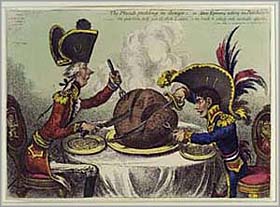 |
|||||||||
 |
|||||||||
|
|||||||||
© Great Caricatures
2023
![]() REVIEW
REVIEW ![]()
James Gillray at the NYPL
T |
he New York Public Library's exhibition of James Gillray's works |
was one of the largest exhibitions of its kind ever presented in the U.S. Over 160 prints and drawings from the Samuel J. Tilden collection were included. The exhibit was displayed in one of New York's greatest landmarks. After making a donation viewers climbed the grand staircase to the third floor for a chance to experience the Library's architecture before being immersed in masterpieces from the early days of political caricature. |
|
Etching with engraving Image courtesy of the New York Public Library |
Gillray's works were elegantly installed
in two softly-lit marble corridors. The prints were closely hung (and
sometimes double-hung) in simple, dark wooden frames that ran the length
of the walls. Original works were shown in antique display cases.
This exhibition offered a rare opportunity to view a large number of Gillray's major works. It also provided examples of his working methods through original sketches and annotated preparatory drawings. There were also oil paper tracings that Gillray used to transfer his drawings to plates.
Virtually all of Gillray's best-known works were on display: Very Slippy Weather, Presages of the Millenium, John Bull Taking a Luncheon, The Plumb-pudding in danger, Sin, Death and the Devil, Tiddy-Doll, the Great French Gingerbread-Baker (shown with a preparatory sketch) and many more. All but one of the works were from hand-colored editions that dealers offered to their wealthier customers during Gillray's lifetime. The selection provided an excellent overview of Gillray's satirical brilliance. Each print was accompanied by text written by the exhibition curator, Roberta Wadell that clearly articulated the historical and political context of the work.
A rare correspondence written by Gillray in 1800 offered a glimpse into his personality and the complications that could emerge in his business dealings. At the time, Gillray had been commissioned to illustrate Poetry of the Anti-Jacobin but was forbidden to include personal caricatures. In this letter, Gillray refused to let his editor see the work until it was finished. Ultimately, the dispute led to the end of Gillray's involvement with the publication and the destruction of his plates.
There was more to be appreciated in this exhibit than could be absorbed in a single visit, but an important aspect of Gillray's work that wasn't emphasized through the prints was his skill as a draftsman and engraver. While the hand-coloring can make Gillray's prints interesting decorative objects, it tends to obscure much of the detail and make the aquatints look muddy. In The Apotheosis of Hoche, for example, the landscape and multitude of figures at the bottom of the print are all but obscured by a heavy application of red paint. The black and white version of Begging No Robbery has a beautiful spatial quality (created by variations in the thickness of line) that is all but flattened in the color version. Gillray's flamboyant linework and meticulous rendering techniques express his obsessive and visionary nature. These qualities are most visible in the black and white editions of his prints, only two of which were on display in the exhibit.
Although most of the linework suffers from the coloring, a few prints have details that are enhanced. The diaphanous fabric of ci-devant Occupations is nicely rendered by it's elegant coloring and The Union Club, while losing some of the chaotic frivolity of the black and white edition, is boldly illuminated with blues and reds. Most prints were painted by women who followed guides created by Gillray, but some versions show dramatic variations. The Library's collection includes two versions of Monstrous Craws (one of which is included in this exhibit) that demonstrate how colorists applied different techniques.
The works on display present a broad overview of Gillray's work, yet it represents a mere 16% of the Tilden Gillray collection. While the opportunity presented itself, the organizers declined the chance to present the floor-to-ceiling style of installation that was found in early 19th century caricature exhibitions. As a result, the experience for the viewer was satisfying without being oversaturating. Even after viewing the more than 160 works on display, it was possible to leave the exhibit wanting more — and that's one the best indications of a well-crafted exhibit.
While it's probably impossible for a single exhibition to encapsulate all of the historical, political, and esthetic layers of significance that can be found in Gillray's work, this exhibit captured most of them. The Library's Print Department has made an important contribution to Gillray's legacy and, thanks to the online version of the exhibit, has created one of the best Gillray references on the Internet.
David Donihue
